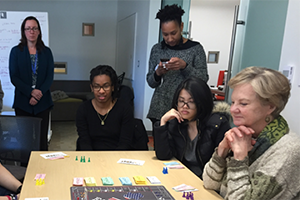Communications
10 Inclusion Tips for the First Day of Class and Beyond

Professor Leena Jayaswal, inclusion officer for American University School of Communication (AU SOC), put together this list of tips to help faculty create inclusive classrooms, but many of the ideas can be applied to any workplace or community group. Jayaswal is a member of SOC’s Diversity Committee, which strives to maintain a sustainable environment that welcomes and nurtures diversity in all aspects, including diversity within SOC, its student body, staff, faculty, curriculum and teaching, creative, scholarly and professional activity, and service. We hope you will find it useful!
Top 10 Inclusion Tips
Are you ready for spring semester? As you're drafting your syllabus or thinking about guest speakers, be sure you're creating a classroom where everyone feels comfortable in expressing their varied perspectives, in a safe and compassionate environment.
1. Roll call and Introduction- If possible, introduce yourself individually to each student as they walk into your class. That way, they also get an individualized introduction from the student too. It's a personal touch that could help foster connectivity. Ask students to introduce themselves, rather than read through the roster, this way they can identify as they choose. This will put the students who do not identify as their roster name at ease. Model that behavior in your own introduction. More on the importance of introductions here.
2. Pronouns Matter- Introduce yourself and identify the pronouns you use. Gender has been ingrained socially and culturally, it takes intentional practice to shift away from this. More on this important topic for our non-binary and transgender students here.
3. Learn students names- Seems like an obvious statement, but many students often complain that professors don’t know their names. For tips on remembering names please read here.
4. Group work- When assigning group projects insist that the groups are diverse as possible with regards to gender, race, nationality and major. Ask all students to present and have them set up ground rules for the group. More information here.
5. Make sure your syllabus is written in a gender-neutral language or in terms of gender inclusive terms- point out material that you are using that is dated in terms of gender, race and other outdated notions. Think about how you address the group and try to be consistent. More information here.
6. Look at the books, readings, and visual representations you adopt for the semester. Are they gender neutral, diverse perspectives, do they favor men over women? More and more students will be asking for varied viewpoints. A reminder that professors should not single out any students as representative of a category even if they think they are offering them a platform to speak. More information here.
7. If you have smaller classes ask the students not to sit in the same seat each class. (It does make learning their names a challenge but might be worth it!) This allows the students to meet people not like them. Give them two minutes at the beginning of class for them to ask questions of each other.
8. Ask students to list groups/ clubs they belong to and encourage them to announce club activities in class, or via blackboard.
9. Don‘t talk over a student when they are commenting or asking questions. Sometimes when women or international students are speaking the tendency is to finish their thoughts. Try to be aware if you are consistently doing this. More information here.
10. Verbal and non-verbal cues- How you speak and your body language says a lot to the students in the classroom. Try using a dialogue not debate class discussion style when and if appropriate. More information here.
